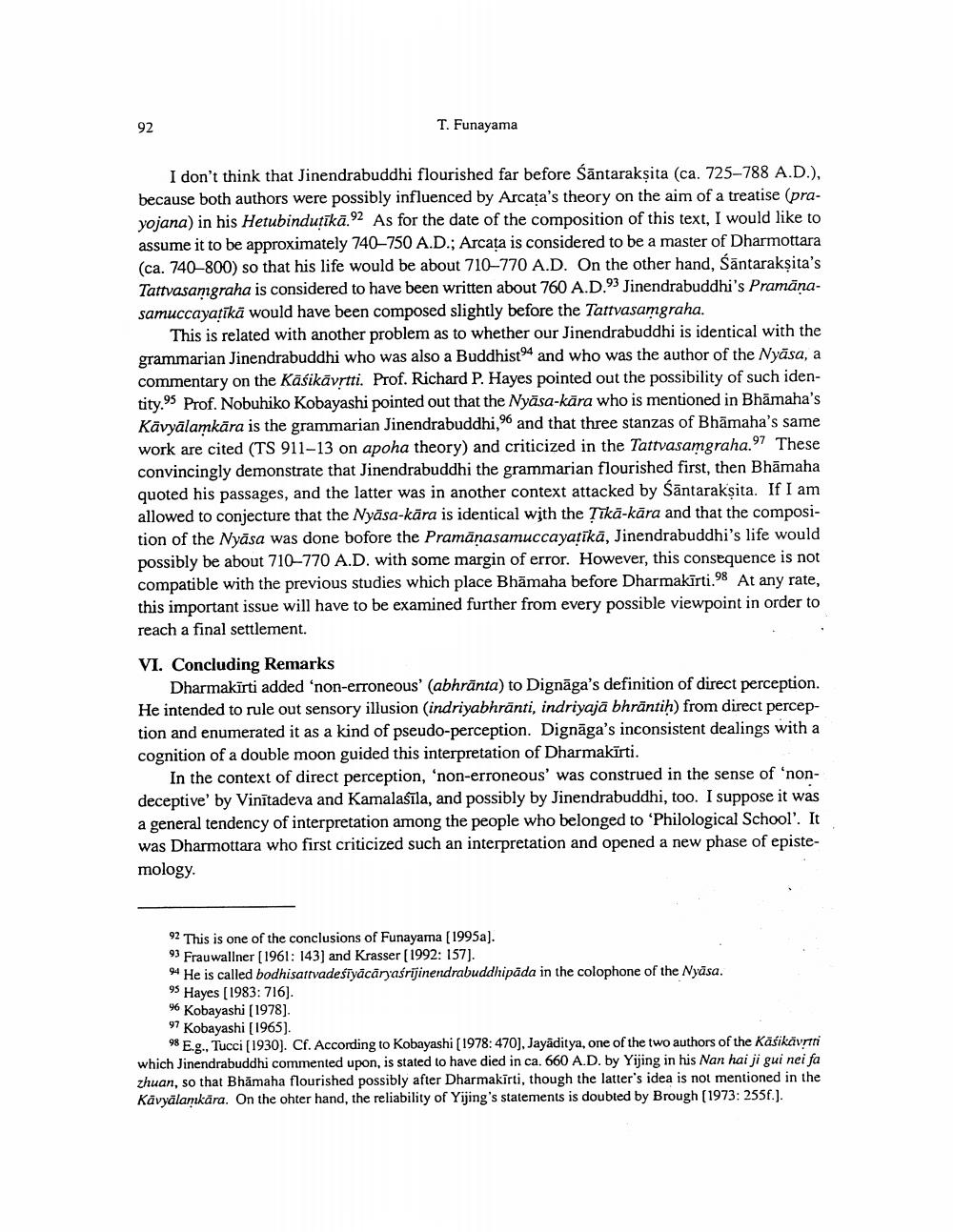________________
T. Funayama
I don't think that Jinendrabuddhi flourished far before sāntarakṣita (ca. 725-788 A.D.), because both authors were possibly influenced by Arcata's theory on the aim of a treatise (prayojana) in his Hetubindutīkā.92 As for the date of the composition of this text, I would like to assume it to be approximately 740-750 A.D.; Arcata is considered to be a master of Dharmottara (ca. 740–800) so that his life would be about 710–770 A.D. On the other hand, Santaraksita's Tattvasangraha is considered to have been written about 760 A.D.93 Jinendrabuddhi's Pramānasamuccayațīkā would have been composed slightly before the Tattvasamgraha.
This is related with another problem as to whether our Jinendrabuddhi is identical with the grammarian Jinendrabuddhi who was also a Buddhist 94 and who was the author of the Nyāsa, a commentary on the Käsikāvrtti. Prof. Richard P. Hayes pointed out the possibility of such identity.% Prof. Nobuhiko Kobayashi pointed out that the Nyäsa-kāra who is mentioned in Bhāmaha's Kävyālamkāra is the grammarian Jinendrabuddhi, and that three stanzas of Bhāmaha's same work are cited (TS 911-13 on apoha theory) and criticized in the Tattvasamgraha.97 These convincingly demonstrate that Jinendrabuddhi the grammarian flourished first, then Bhāmaha quoted his passages, and the latter was in another context attacked by Säntarakṣita. If I am allowed to conjecture that the Nyāsa-kāra is identical with the Tikä-kära and that the composition of the Nyasa was done bofore the Pramānasamuccayatīkā, Jinendrabuddhi's life would possibly be about 710–770 A.D. with some margin of error. However, this consequence is not compatible with the previous studies which place Bhāmaha before Dharmakīrti.98 At any rate, this important issue will have to be examined further from every possible viewpoint in order to reach a final settlement.
VI. Concluding Remarks
Dharmakirti added 'non-erroneous' (abhrānta) to Dignāga's definition of direct perception. He intended to rule out sensory illusion (indriyabhrānti, indriyajā bhrāntih) from direct perception and enumerated it as a kind of pseudo-perception. Dignāga's inconsistent dealings with a cognition of a double moon guided this interpretation of Dharmakīrti.
In the context of direct perception, 'non-erroneous' was construed in the sense of 'nondeceptive' by Vinītadeva and Kamalaśīla, and possibly by Jinendrabuddhi, too. I suppose it was a general tendency of interpretation among the people who belonged to 'Philological School. It was Dharmottara who first criticized such an interpretation and opened a new phase of epistemology
92 This is one of the conclusions of Funayama (1995a). 9 Frauwallner (1961: 143) and Krasser (1992: 157). 94 He is called bodhisattvadesīyācāryasrijinendrabuddhipada in the colophone of the Nyasa. 95 Hayes (1983: 716). 46 Kobayashi (1978) 97 Kobayashi (1965).
98 E.... Tucci (1930). Cf. According to Kobayashi (1978: 470], Jayaditya, one of the two authors of the Käsikävrti which Jinendrabuddhi commented upon, is stated to have died in ca. 660 A.D. by Yijing in his Nan hai ji gui nei fa zhuan, so that Bhămaha flourished possibly after Dharmakirti, though the latter's idea is not mentioned in the Kävyälamkāra. On the ohter hand, the reliability of Yijing's statements is doubted by Brough (1973: 255f.).




